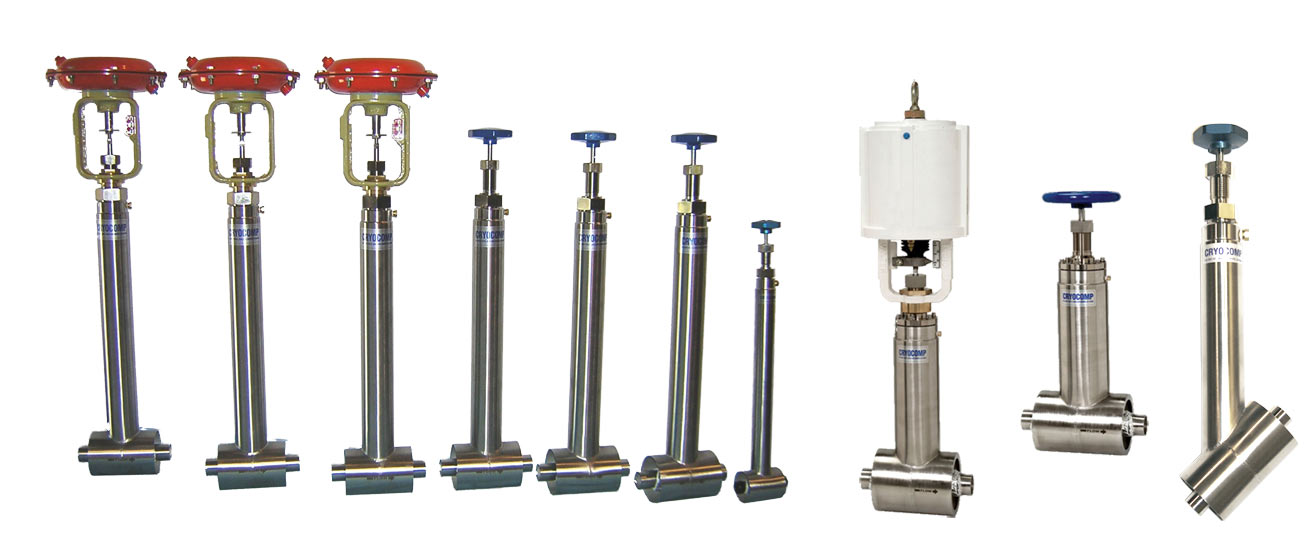
Cryogenic liquid valves control the flow of liquid super-cooled gases like nitrogen, hydrogen, argon, oxygen, and helium. The gases must be kept extremely cold to stay liquid, so cryogenic valves are designed to function while minimizing warming. Cryogenic valve specification depends on the cryogen, the system or equipment the valve will be a part of, the way the valve will open and close, the pressure and flow rate of the liquid, and any safety or convenience features required.
Is this valve for a liquid hydrogen or helium system?
Because liquid hydrogen and liquid helium boiloff (becomes a gas again) at an extremely low temperature, the ideal valve has a stem and support tube designed for low heat conduction. As a result, the valves operate with the lowest possible rate of heat leak. Cryocomp’s C3000 valve series is specially designed for liquid helium systems
Is this valve for a liquid nitrogen, argon, or oxygen system?
A liquid nitrogen valve design can also be used for argon or oxygen. However, special cleaning is required if the valve will be used for oxygen service. Cryocomp’s C2000 and C5000 series valves are ideal for these cryogens.
Does the liquid need to flow straight through the valve?
If so, specify a globe or y-pattern valve. A globe-style valve is a common design in which the valve stem is perpendicular to the flow of liquid. A y-pattern valve stem is at an angle to the liquid flow. Because of this design, y-pattern valves can fit into smaller spaces. Use a right angle style valve if the liquid flow must change direction. Cryocomp valves by body style.
What size is the piping?
We make valves sized to match industry-standard piping or tubing. Cryocomp valves will fit ½” tube to 2” piping systems.
How will the valve connect with the cryogenic system?
The most common types of connections are pipe or tube weld ends. We can manufacture cryogenic liquid valves with other connections, like MPT, VCR or FPT threads, a flare tube and nut, socket weld pipe or tube, or socket weld copper.
Will the valve require actuated operation?
Actuated valves stop or start the flow of liquid. Pneumatically actuated valves are powered by compressed air, and solenoid valves are powered by electricity. Actuated valves can be automated. Manual valves turn the liquid flow on or off with a simple handle turn.
Will the valve need a purge port and/or a relief valve?
A purge port allows access to the vacuum space, and a relief valve is a safety feature that will open at a pre-determined pressure.
Does your application require more than a single valve?
A manifold valve can incorporate any number of manual or actuated valves in a single unit. For example, a custom-designed manifold can have bayonet connections, tee or elbow joints, flexible hose, expansion joints, or instrumentation.
We are specialists in cryogenic valves and would be happy to discuss your specific application. Contact us today, at sales@cryocomp.com, or simply fill out the quote request form.
Joe is a product manager for Cryofab. After studying sales and marketing at Providence College, Joe joined Cryofab in 2021 to assist in managing the Cryocomp product line. With a focus on valves and evacuation components, Joe is happy to be a resource for any cryogenic related questions or inquiries.
